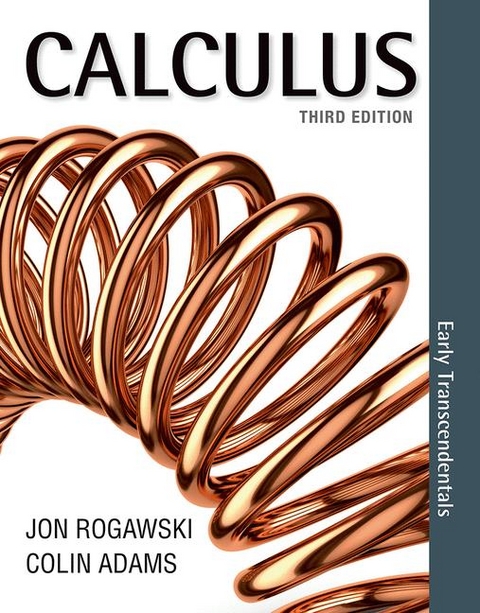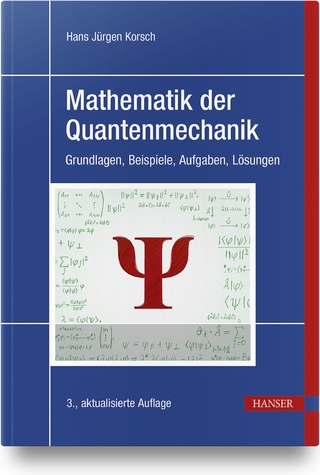
Calculus: Early Transcendentals
W.H.Freeman & Co Ltd (Verlag)
978-1-4641-1488-5 (ISBN)
- Titel erscheint in neuer Auflage
- Artikel merken
The most successful calculus book of its generation, Jon Rogawski's Calculus offers an ideal balance of formal precision and dedicated conceptual focus, helping students build strong computational skills while continually reinforcing the relevance of calculus to their future studies and their lives.
Guided by new author Colin Adams, the new edition stays true to the late Jon Rogawski's refreshing and highly effective approach, while drawing on extensive instructor and student feedback, and Adams' three decades as a calculus teacher and author of math books for general audiences.
The new edition is also a fully integrated text/media package, with its own dedicated version of LaunchPad, W. H. Freeman's breakthrough online course space.
Jon Rogawski received his undergraduate degree (and simultaneously a master's degree in mathematics) at Yale, and a Ph.D. in mathematics from Princeton University, where he studied under Robert Langlands. Prior to joining the Department of Mathematics at UCLA, where he is currently Full Professor, he held teaching positions at Yale and the University of Chicago, and research positions at the Institute for Advanced Study and University of Bonn. Jon's areas of interest are number theory, automorphic forms, and harmonic analysis on semisimple groups. He has published numerous research articles in leading mathematical journals, including a research monograph entitled Automorphic Representations of Unitary Groups in Three Variables (Princeton University Press). He is the recipient of a Sloan Fellowship and an editor of The Pacific Journal of Mathematics. Jon and his wife Julie, a physician in family practice, have four children. They run a busy household and, whenever possible, enjoy family vacations in the mountains of California. Jon is a passionate classical music lover and plays the violin and classical guitar. Colin Adams is the Thomas T. Read Professor of Mathematics at Williams College, where he has taught since 1985. He has produced a number of books that make mathematics more accessible and relatable, including How to Ace Calculus and its sequel, How to Ace the Rest of Calculus; Riot at the Calc Exam and other Mathematically Bent Stories; and Zombies & Calculus. Colin co-wrote and appears in the videos "The Great Pi vs. E Debate" and "Derivative vs. Integral: the Final Smackdown."
Rogawski/Adams: Calculus Early Transcendentals 3e Table of Contents .- Chapter 1: Precalculus Review 1.1 Real Numbers, Functions, and Graphs 1.2 Linear and Quadratic Functions 1.3 The Basic Classes of Functions 1.4 Trigonometric Functions 1.5 Inverse Functions 1.6 Exponential and Logarithmic Functions 1.7 Technology: Calculators and Computers Chapter Review Exercises .- Chapter 2: Limits 2.1 Limits, Rates of Change, and Tangent Lines 2.2 Limits: A Numerical and Graphical Approach 2.3 Basic Limit Laws 2.4 Limits and Continuity 2.5 Evaluating Limits Algebraically 2.6 Trigonometric Limits 2.7 Limits at Infinity 2.8 Intermediate Value Theorem 2.9 The Formal Definition of a Limit Chapter Review Exercises .- Chapter 3: Differentiation 3.1 Definition of the Derivative 3.2 The Derivative as a Function 3.3 Product and Quotient Rules 3.4 Rates of Change 3.5 Higher Derivatives 3.6 Trigonometric Functions 3.7 The Chain Rule 3.8 Implicit Differentiation 3.9 Derivatives of General Exponential and Logarithmic Functions 3.10 Related Rates Chapter Review Exercises .- Chapter 4: Applications of the Derivative 4.1 Linear Approximation and Applications 4.2 Extreme Values 4.3 The Mean Value Theorem and Monotonicity 4.4 The Shape of a Graph 4.5 L'Hopital's Rule 4.6 Graph Sketching and Asymptotes 4.7 Applied Optimization 4.8 Newton's Method Chapter Review Exercises .- Chapter 5: The Integral 5.1 Approximating and Computing Area 5.2 The Definite Integral 5.3 The Indefinite Integral 5.4 The Fundamental Theorem of Calculus, Part I 5.5 The Fundamental Theorem of Calculus, Part II 5.6 Net Change as the Integral of a Rate 5.7 Substitution Method 5.8 Further Transcendental Functions 5.9 Exponential Growth and Decay Chapter Review Exercises .- Chapter 6: Applications of the Integral 6.1 Area Between Two Curves 6.2 Setting Up Integrals: Volume, Density, Average Value 6.3 Volumes of Revolution 6.4 The Method of Cylindrical Shells 6.5 Work and Energy Chapter Review Exercises .- Chapter 7: Techniques of Integration 7.1 Integration by Parts 7.2 Trigonometric Integrals 7.3 Trigonometric Substitution 7.4 Integrals Involving Hyperbolic and Inverse Hyperbolic Functions 7.5 The Method of Partial Fractions 7.6 Strategies for Integration 7.7 Improper Integrals 7.8 Probability and Integration 7.9 Numerical Integration Chapter Review Exercises .- Chapter 8: Further Applications of the Integral and Taylor Polynomials 8.1 Arc Length and Surface Area 8.2 Fluid Pressure and Force 8.3 Center of Mass 8.4 Taylor Polynomials Chapter Review Exercises .- Chapter 9: Introduction to Differential Equations 9.1 Solving Differential Equations 9.2 Models Involving y^'=k(y-b) 9.3 Graphical and Numerical Methods 9.4 The Logistic Equation 9.5 First-Order Linear Equations Chapter Review Exercises .- Chapter 10: Infinite Series 10.1 Sequences 10.2 Summing an Infinite Series 10.3 Convergence of Series with Positive Terms 10.4 Absolute and Conditional Convergence 10.5 The Ratio and Root Tests 10.6 Power Series 10.7 Taylor Series Chapter Review Exercises .- Chapter 11: Parametric Equations, Polar Coordinates, and Conic Sections 11.1 Parametric Equations 11.2 Arc Length and Speed 11.3 Polar Coordinates 11.4 Area and Arc Length in Polar Coordinates 11.5 Conic Sections Chapter Review Exercises .- Chapter 12: Vector Geometry 12.1 Vectors in the Plane 12.2 Vectors in Three Dimensions 12.3 Dot Product and the Angle Between Two Vectors 12.4 The Cross Product 12.5 P.
| Zusatzinfo | 1050 p. |
|---|---|
| Sprache | englisch |
| Maße | 214 x 277 mm |
| Themenwelt | Mathematik / Informatik ► Mathematik ► Analysis |
| Naturwissenschaften | |
| ISBN-10 | 1-4641-1488-9 / 1464114889 |
| ISBN-13 | 978-1-4641-1488-5 / 9781464114885 |
| Zustand | Neuware |
| Haben Sie eine Frage zum Produkt? |
aus dem Bereich



